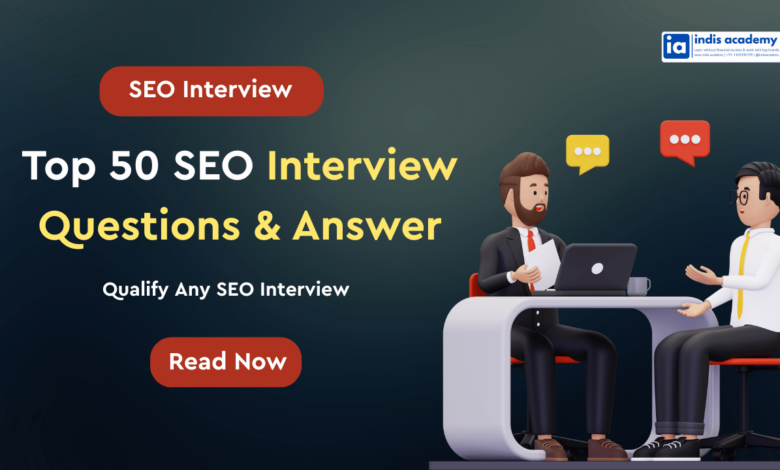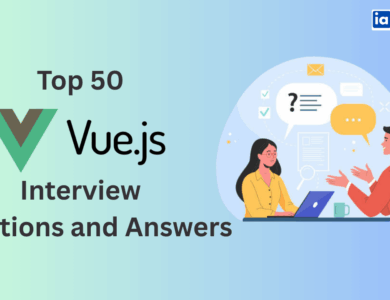50+ SEO Interview Question To Crack Any SEO Interview

So, you’ve landed an SEO interview. Great! But now you’re wondering — What questions will they ask? How deep will they go? And most importantly — Am I ready?
Whether you’re a complete beginner or someone eyeing a senior role, this guide has you covered.
I’ve compiled 50+ SEO interview questions, divided by experience level, each with a clear, confident answer you can use to impress any interviewer.
Let’s dive in.
Learn AI & Digital Marketing,
Pay Fees After Placement
- ✅ Minimal Admission Fees
- ✅ No Loan or Income Sharing Agreement
- ✅ 100% Placement Support
- ✅ ISO & Govt Registered Certificate
- ✅ Practical 3+1 Months Duration
Get a free counseling call. We’ll guide you through learning, certification, and job placement.
Request a Free Call Back
Takes less than a minute.
20 SEO Interview Questions & Answers for Freshers
Here’s where the fundamentals matter. If you’re applying for an entry-level SEO job, expect these kinds of questions:
1. What is SEO?
Answer: SEO stands for Search Engine Optimization. It’s the process of optimizing a website to improve its visibility in search engine results, which drives organic (unpaid) traffic to the site.
2. Why is SEO important for a website?
Answer: SEO helps websites rank higher on search engines like Google, which means more visibility, more traffic, and ultimately more leads or sales without paying for ads.
3. What are the different types of SEO?
Answer:
- On-Page SEO (optimizing content, HTML, and structure)
- Off-Page SEO (building backlinks, brand mentions)
- Technical SEO (site speed, mobile-friendliness, indexing)
4. What is a keyword in SEO?
Answer: A keyword is the word or phrase that users type into search engines. SEO involves optimizing your content around these keywords to match user intent.
5. What is the difference between On-Page and Off-Page SEO?
Answer:
- On-Page SEO refers to everything you control on your site (content, titles, internal links).
- Off-Page SEO is about actions outside your website, like backlinks from other sites.
6. What is a backlink?
Answer: A backlink is a link from another website pointing to your site. It signals trust and authority to search engines, helping you rank higher.
7. What is a meta title and meta description?
Answer:
- Meta Title is the clickable title shown in search results.
- Meta Description is the short snippet shown below it. Both impact click-through rates and SEO.
8. What are long-tail keywords?
Answer: Long-tail keywords are longer, more specific phrases (e.g., “best budget DSLR camera under 50000”). They have lower competition and higher conversion rates.
9. What is a sitemap?
Answer: A sitemap is a file that lists all the pages on your website. It helps search engines crawl your site more efficiently.
10. What tools do you use for SEO?
Answer: Some beginner-friendly tools include:
- Google Search Console
- Google Analytics
- Ubersuggest
- Yoast SEO (for WordPress)
11. What is crawling and indexing?
Answer:
- Crawling is when search engines discover new or updated pages.
- Indexing is when those pages are stored and made eligible to appear in search results.
12. How does Google rank websites?
Answer: Google ranks pages based on relevance, quality of content, backlinks, user experience, page speed, and over 200 other ranking factors.
13. What is the difference between organic and paid results?
Answer:
- Organic results are unpaid listings achieved through SEO.
- Paid results are ads you pay for, like Google Ads.
14. What is black hat SEO?
Answer: Black hat SEO involves unethical techniques like keyword stuffing, cloaking, and buying links. These can lead to penalties or being deindexed.
15. What is white hat SEO?
Answer: White hat SEO follows search engine guidelines to improve rankings — through quality content, user experience, and ethical link building.
16. What is domain authority (DA)?
Answer: DA is a score (developed by Moz) from 0 to 100 that predicts how well a website will rank. Higher DA generally means better chances of ranking.
17. What is robots.txt?
Answer: It’s a file that tells search engines which parts of your site they can or cannot crawl.
18. What are broken links?
Answer: Broken links are links that lead to non-existent pages (404 errors). They harm SEO and user experience.
19. What is canonicalization?
Answer: It’s the process of selecting the preferred version of a web page when there are multiple versions of the same content (to avoid duplicate content issues).
20. What is the difference between a dofollow and nofollow link?
Answer:
- Dofollow links pass SEO value (link juice).
- Nofollow links don’t pass SEO value but can still bring traffic.
20 SEO Interview Questions & Answers for Mid-Level Professionals
This is where strategy and analysis come in. Employers will expect hands-on experience and practical insights.
21. How do you perform keyword research?
Answer: I use tools like Google Keyword Planner, Ahrefs, and SEMrush to find keywords based on search volume, difficulty, and user intent. I also analyze competitor keywords and look for content gaps.
22. How do you optimize a website’s content?
Answer: I optimize titles, meta descriptions, headers, images (with alt text), internal linking, and ensure the content matches the search intent and includes target keywords naturally.
23. What’s your approach to link building?
Answer: I focus on quality over quantity — guest posting, resource link building, broken link outreach, and creating valuable content that earns backlinks naturally.
24. What is Core Web Vitals and why do they matter?
Answer: Core Web Vitals are a set of metrics (LCP, FID, CLS) that measure user experience in terms of load time, interactivity, and visual stability. Google uses them as a ranking factor.
25. What is the difference between a 301 and 302 redirect?
Answer:
- 301 is a permanent redirect that passes full link equity.
- 302 is a temporary redirect that doesn’t pass full SEO value.
26. How do you analyze competitor websites?
Answer: I check their top-performing pages, backlink profile, keyword rankings, content strategy, and technical setup using tools like Ahrefs, SEMrush, and SimilarWeb.
27. What is structured data?
Answer: Structured data (schema markup) helps search engines understand your content better and enables rich results like star ratings, FAQs, etc.
28. How do you fix crawl errors in Search Console?
Answer: I regularly monitor Search Console, identify 404 or server errors, fix broken links or redirects, and resubmit the updated pages for indexing.
29. What is an SEO audit and how do you perform it?
Answer: An SEO audit is a complete analysis of a website to identify issues affecting performance. I check technical health, content quality, backlinks, keyword usage, mobile usability, and more.
30. How do you track SEO performance?
Answer: Using tools like Google Analytics, Google Search Console, and Ahrefs, I monitor organic traffic, keyword rankings, CTR, bounce rate, and conversion rates.
31. How do you handle duplicate content?
Answer: I use canonical tags, 301 redirects, or rewrite content to make it unique. I also avoid thin or automatically generated pages.
32. What’s your strategy for local SEO?
Answer: I optimize Google Business Profile, local citations, reviews, and use geo-targeted keywords. I also ensure consistent NAP (Name, Address, Phone Number) across platforms.
33. How do you approach SEO for eCommerce sites?
Answer: I focus on product schema, unique product descriptions, optimizing category pages, internal linking, and fixing duplicate content due to filters or pagination.
34. What’s your process for content planning in SEO?
Answer: I start with keyword clustering, competitor research, and intent mapping. Then I create a content calendar with blog topics, optimize them, and track their performance.
35. How do you stay updated with SEO trends?
Answer: I follow blogs like Moz, Search Engine Journal, and Google’s official channels. I also attend webinars and SEO forums.
36. What’s your take on voice search optimization?
Answer: Voice search queries are longer and conversational. I optimize for long-tail, question-based keywords and create content that answers them directly.
37. What is bounce rate?
Answer: It’s the percentage of visitors who leave a page without taking any action. A high bounce rate can indicate poor content or bad user experience.
38. What are LSI keywords?
Answer: Latent Semantic Indexing (LSI) keywords are contextually related terms to the main keyword. They help improve content relevance and depth.
39. What is a disavow file?
Answer: A disavow file tells Google to ignore spammy or low-quality backlinks to your site, helping avoid penalties.
40. How do you handle a drop in traffic?
Answer: I first check for algorithm updates, technical issues, manual actions, or lost backlinks. Then I identify affected pages and fix any content or technical problems.
10 SEO Interview Questions & Answers for Experienced Professionals
These are for leadership roles — expect more strategic, analytical, and team-driven questions.
41. How do you build and lead an SEO strategy from scratch?
Answer: I start with a full site audit, define business goals, perform in-depth keyword research, map content, fix technical issues, build a backlink strategy, and create regular reports.
42. How do you integrate SEO with content marketing?
Answer: I align content with search intent, optimize blogs and landing pages, and collaborate with content teams to create SEO-driven assets that drive both traffic and conversions.
43. Have you handled SEO during a site migration?
Answer: Yes, I ensure proper 301 redirects, update internal links, maintain URL structure where possible, and monitor traffic/rankings closely post-launch.
44. How do you measure the ROI of SEO?
Answer: I compare the cost of SEO efforts with the value of organic traffic, conversions, and lifetime customer value using tools like Google Analytics and CRM integration.
45. What’s your approach to scaling SEO efforts?
Answer: I focus on automation, templated content creation, internal processes, team collaboration, and constantly refine the SEO stack (tools + resources).
46. Have you handled international SEO?
Answer: Yes, I use hreflang tags, country-specific domains or subfolders, and ensure geo-targeted content. I also localize keywords and structure for each region.
47. How do you deal with negative SEO attacks?
Answer: I monitor backlink profiles regularly, disavow spammy links, secure my site, and report malicious activities to Google.
48. How do you present SEO results to non-technical stakeholders?
Answer: I focus on business metrics — traffic, leads, revenue. I simplify jargon, use visual dashboards, and tie every result to ROI.
49. What is E-E-A-T and how do you improve it?
Answer: E-E-A-T stands for Experience, Expertise, Authoritativeness, and Trustworthiness. I improve it by showcasing credentials, building author bios, getting quality backlinks, and using clear, fact-checked content.
50. What are the most common SEO mistakes you’ve seen?
Answer:
- Ignoring technical SEO
- Targeting wrong keywords
- Thin/duplicate content
- Not tracking ROI
- Treating SEO as a one-time job
Final Words
Preparing for an SEO interview doesn’t have to be stressful — you just need the right strategy.
Now that you’ve gone through these 50+ SEO interview questions and answers, take time to practice, stay confident, and tailor your answers based on your real experience. Employers love genuine, thoughtful responses over memorized ones.
👉 Got an interview coming up? Bookmark this page.
👉 Found this useful? Share it with someone preparing too!





